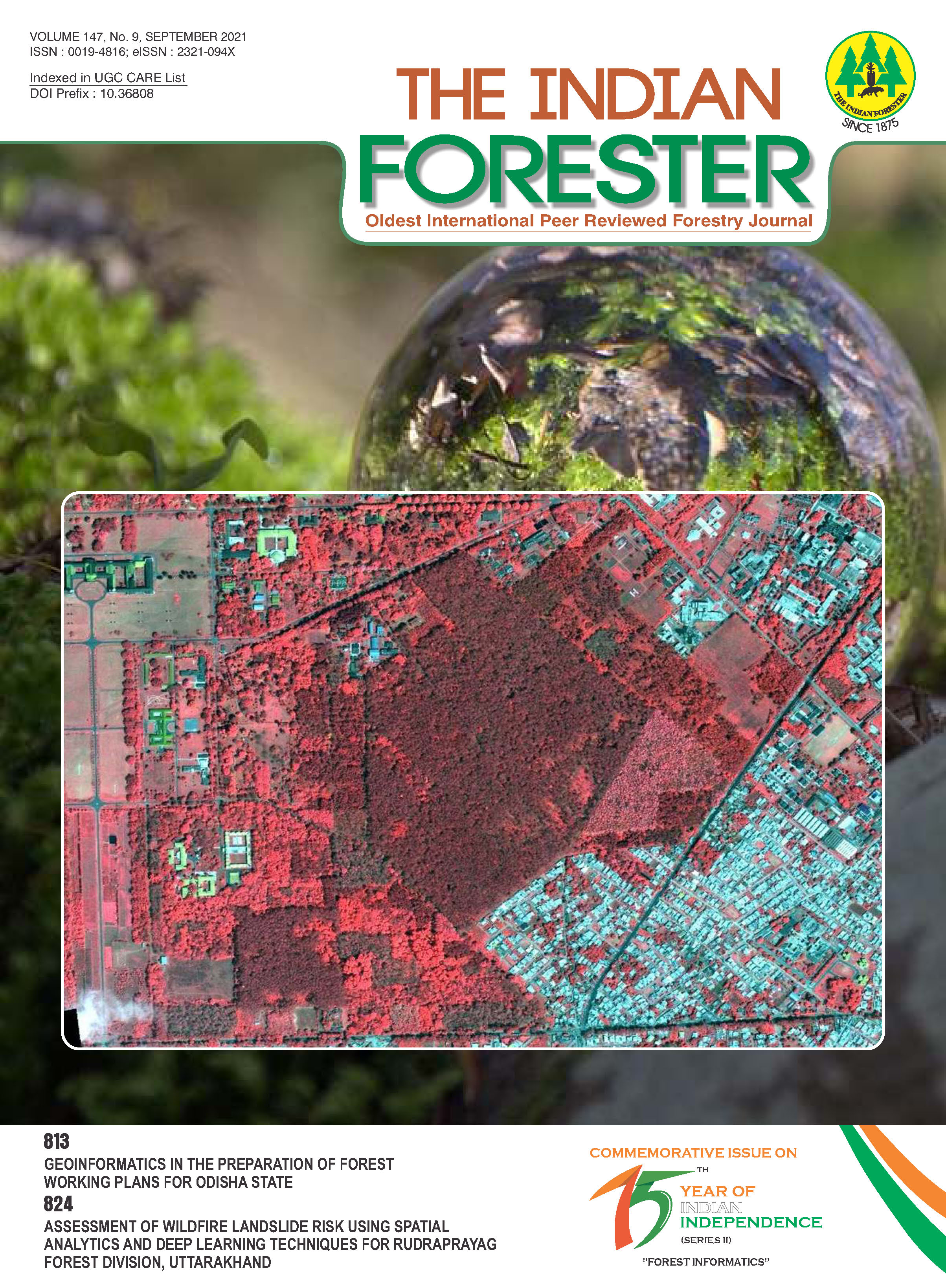Spatial and Temporal Distribution of Water Holes in Sariska Tiger Reserve: A Case Study Demonstrating GIS based Water Management in Landscape of Semi-Arid Aravalli Range, India
DOI:
https://doi.org/10.36808/if/2021/v147i9/155001Keywords:
Waterhole Management, Wildlife, Tiger Reserve, Protected Area.Abstract
Spatial and temporal distribution data of all waterholes, both natural and artificial, in Sariska Tiger Reserve (STR) was collected for one year (March 2018 to February 2019). The close proximity of some perennial water holes to the religious places and heavy pressure of livestock in water holes suggests the need of supplementing water requirement to wild animals with artificial water holes. Besides this, a high congregation of artificial waterholes in some areas was observed leaving behind considerable areas as dry zones. We suggest to review the existing water management plan using GIS techniques based on spatial and temporal distribution of existing perennial water sources.References
Bhardwaj G.S. (2003). Baories for the King- Reviving the traditional water sources in Ranthambhore National park. Geography and you, 3(10&11): 60-64.
Bleich V.C. (2016). Wildlife conservation and wilderness: wishful thinking? Natural Area Journal, 36: 202-206.
Bradford D. (1975). The effects of an artificial water supply on freeliving Peromyscus truei. Journal of Mammalogy, 56: 705-707
Calder W. (1984). Size, function and life history. Harvard University, Cambridge, Massachusetts, 431 p.
Champion H.G. and Seth S.K. (1968). A revised survey of the forest type of India. Government of India Press, Delhi, pp. 404.
Ferry N., Dray S., Fritz H. and Valeix M. (2016). Interspecific interference competition at the resource patch scale: do large herbivores spatially avoid elephants while accessing water? Journal of Animal, Ecology, 85: 1574-1585.
Fryxell J.M. and Synclair A.R.E. (1988). Seasonal migration of the white-eared kob in relation resources. African Journal of Ecology, 26: 17-31.
Gaylard A., Owen-Smith N. and Redfern J. (2003). Surface water availability: implications for heterogeneity and ecosystem process. The Kruger experience (ed. by J.T. du Toit, K.H. Rogers and H.C. Biggs), pp. 332-348. Island Press, Washington, USA.
Gereta E. and Wolanski E. (1998). Water quality-wildlife interaction in the Serengeti National Park, Tanzania. Afr. J. Ecol., 1998, 36(1): 1-14.
Hayward M.W. and Hayward M.D. (2012). "Waterhole use by African Fauna," South African Journal of Wildlife Research, 42(2): 117-127.
Herve F., Sonia S., Pierre-Cyril R., Snoden M., Craig C. and Francois M. (2003). The effects of agricultural fields and human settlements on the use of rivers by wildlife in the midZambezi valley, Zimbabwe. Landscape Ecology, 18(3): 293-302 .
Jarman P.J. (1972). The use of drinking sites, wallows and salt licks by herbivores in the flooded middle Zambezi valley. East African Wildlife Journal, 10: 197-201.
Kie J., Bleich V., Medina A., Yoakum J. and Thomas J. (1994). Managing rangelands for wildlife, p. 663-688. In: Bookhout T. (ed.). Research and management techniques for wildlife and habitats. The Wildlife Society, Bethesda, Maryland.
Krausman P.R., Rosenstock S.S. and Cain J.W. (2006). Developed waters for wildlife: science, perception, values, and controversy. Wildlife Society Bulletin, 34: 563-569.
McNaugthon S.J. (1990). Mineral nutrition and seasonal movements of African migratory ungulates. Nature, 345: 613-615.
Mtahiko M.G.G., Gereta E., Kajuni A.R., Chiombola. E.A.T., Ng'umbi G.Z., Coppolillo P. and Wolanski E. (2006) Towards an ecohydrology-based restoration of the Usangu wetlands and the Great Ruaha River, Tanzania. Wetlands Eco.l Manage. 14: 489-503.
Owen-Smith N. (1996). Ecological guidelines for waterpoints in extensive protected areas. South African Journal of Wildlife Research, 26: 107-112.
Rautenstrauch K.R. and Krausmann P.R. (1989). Influence of water availability on rainfall and movements of desert mule deer. Journal of Mammalogy, 70: 197-201.
Rodgers W.A. and Panwar H.S. (1988). Planing a wildlife protected area network in India Vol. I & II, 1988, Wildlife Institute of India, Dehradun.
Rosenstock S.S., Ballard W.B. and Devos J.C. (1999). Viewpoint: Benefits and impacts of wildlife water developments. Journal of Range Management, 52: 302-311.
Sankar K., Qureshi Q., Mondal K., Worah D., Srivastava T., Gupta S. and Basu S. (2009). Ecological studies in Sariska Tiger Reserve, Rajasthan. Final Report, Wildlife Institute of India, Dehra Dun, p. 145.
Senzota R.B.M. and Mtahiko G. (1990). Effects on wildlife on a waterhole in Mikumi National Park, Tanzania. African Journal of Ecology, 28(2): 147-151
Shekhawat R.S. (2015). Tiger Conservation Plan of Sariska Tiger Reserve, Jaipur, Rajasthan, India
Sirot E., Renaud P.C. and Pays O. (2016). How competition and predation shape patterns of waterhole use by herbivores in arid ecosystems. Animal Behaviour, 118:19-26.
Tsukamoto G. and Stiver S. (eds.). (1990). Wildlife water development. The Wildlife Society-Nevada Chapter, Las Vegas, Nevada. 192 p.
Walker B.H., Emsile R.H., Owen-Smith R.N. and Scholes R.J. (1987). To cull or not to cull: lessons from a southern African drought. Journal of Applied Ecology, 24: 381-401.
Valeix M., Fritz H., Canévet V., Le Bel S. and Madzikanda H. (2009). Do elephants prevent other African herbivores from using waterholes in the dry season? Biodiversity and Conservation, 18: 569-576.
Western D. (1975) Water availability and its influence on the structure and dynamics of large mammal community. East African Wildlife Journal, 13: 265-286.
Williamson D., Williamson J. and Ngwamotsoki K.T. (1988). Wildebeest migration in the Kalahari. African Journal of Ecology, 26: 269-280.
Wolanski E. and Gereta E. (2001). Water quantity and quality as the factors driving the Serengeti ecosystem, Tanzania. Hydrobiologia, 458: 169-180.
Downloads
Downloads
Additional Files
Published
How to Cite
Issue
Section
License
Unless otherwise stated, copyright or similar rights in all materials presented on the site, including graphical images, are owned by Indian Forester.





